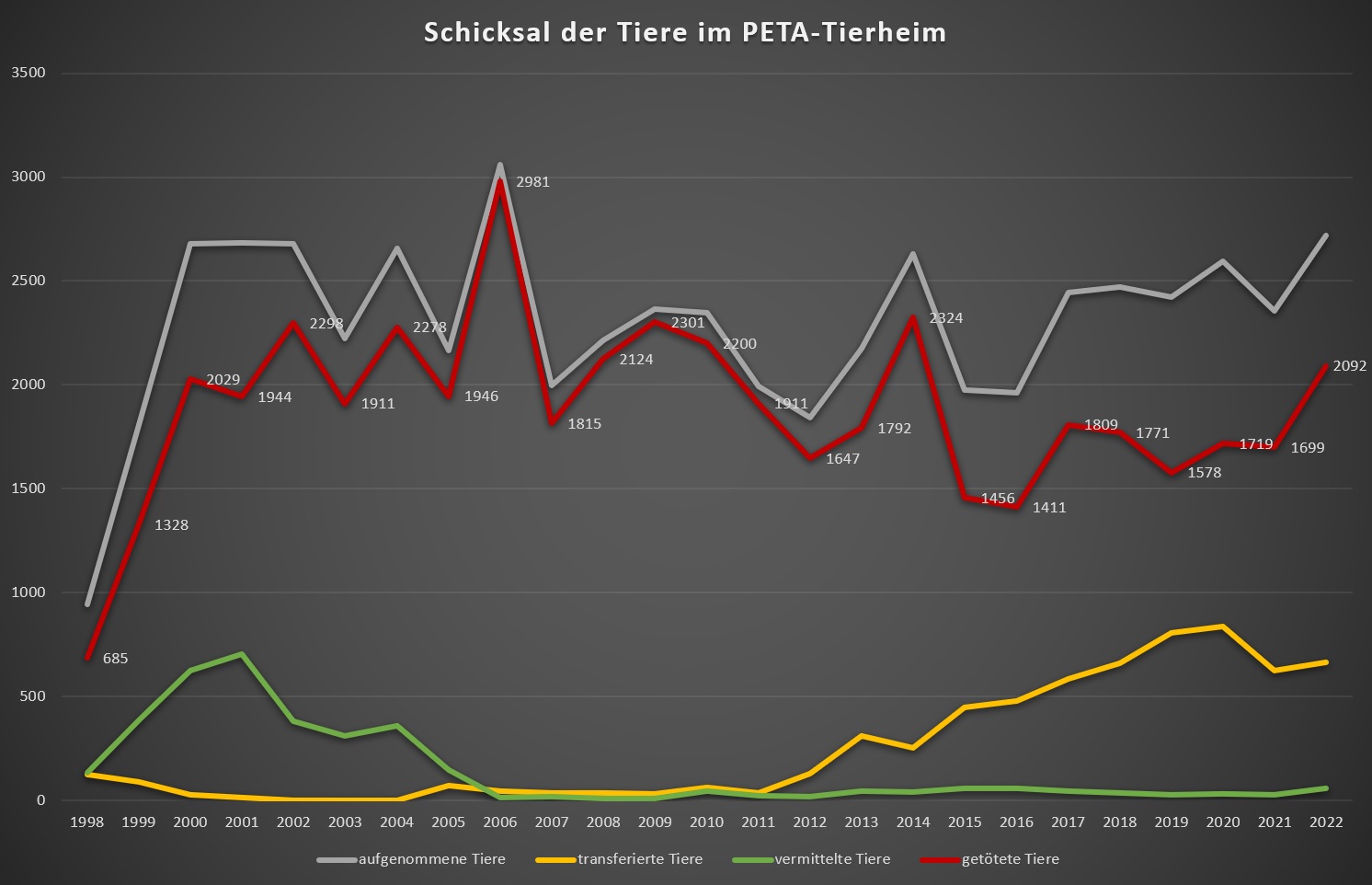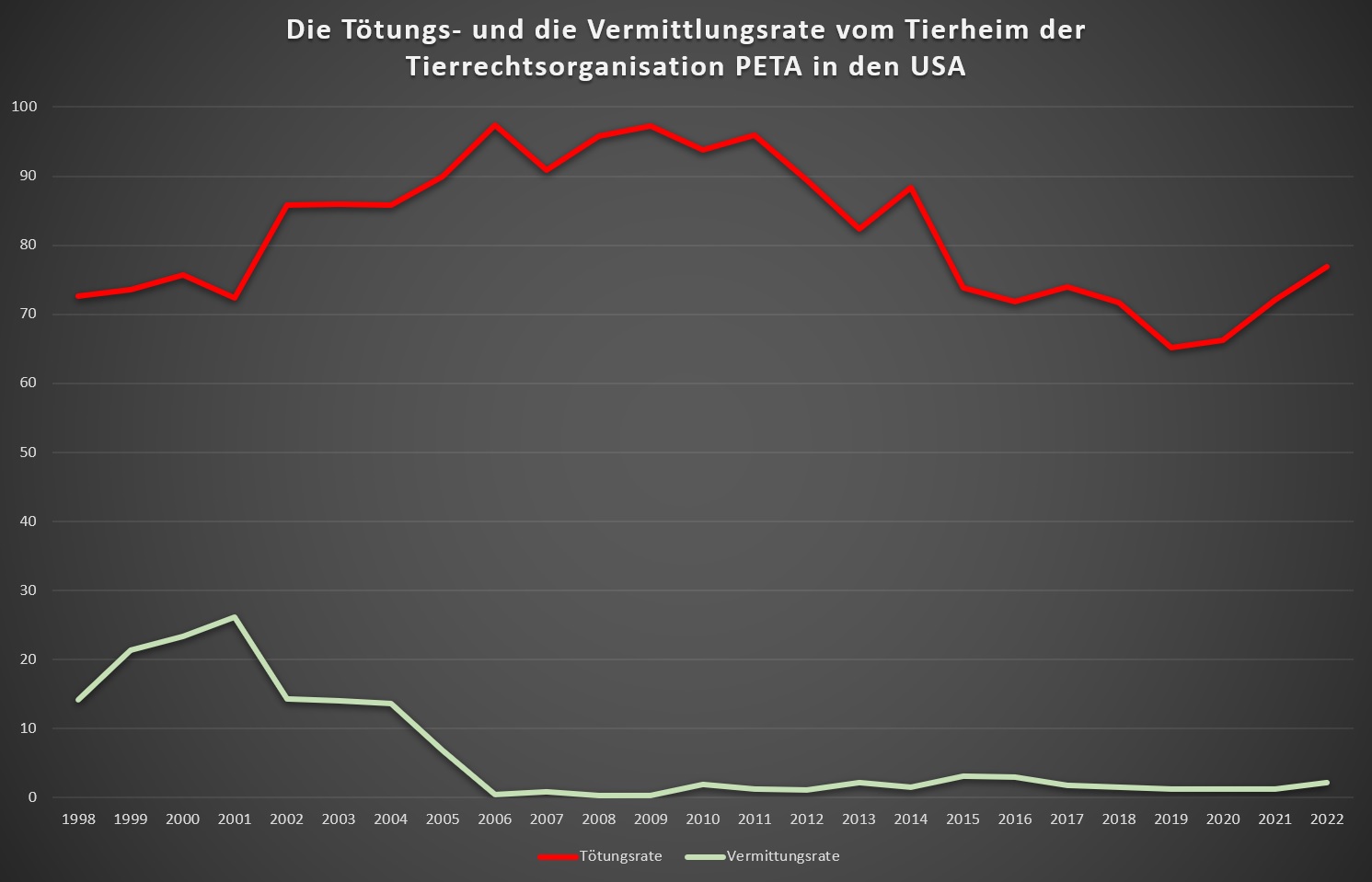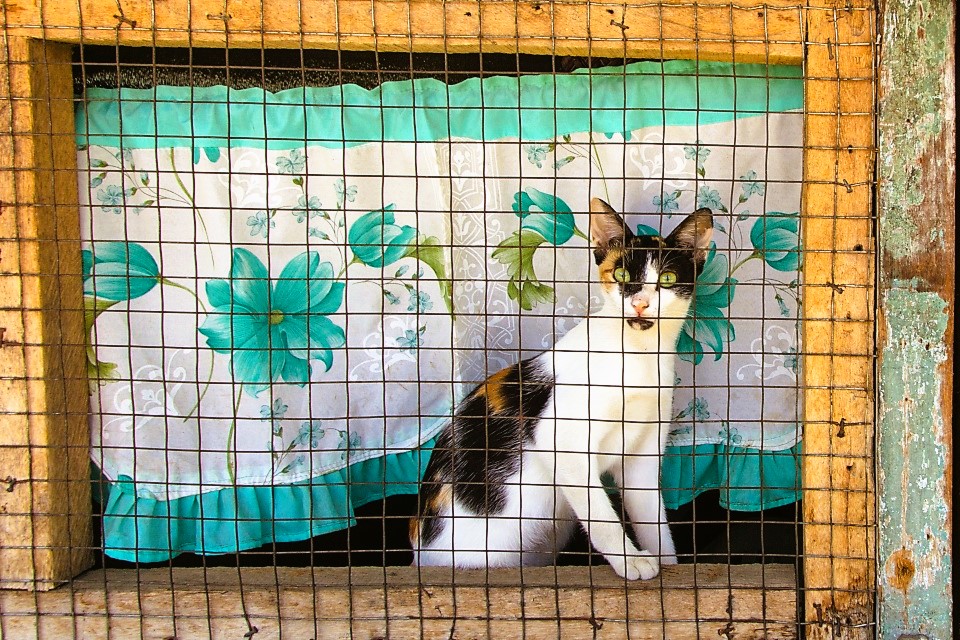Exklusively for zoos.media – 10.02.2023. Author: Philipp J. Kroiß
The kill rate in PETA’s animal shelter has risen significantly once again. In 2022, PETA killed more animals than it had since 2014: over 2,000 dogs, cats, and other pets.
PETA: Animal Killings Pick Up Speed
In the 2020s, the kill rate in PETA’s animal shelter in the US increased by about 5% each year. In Germany, it would be illegal to run such a shelter, however, in the US it is allowed. The same person runs the shelters in both countries and so the German branch cannot elude its own responsibility. If so-called kill shelters were legal in Germany, you could rest assured that PETA would kill thousands of animals here too.
Horrible Figures
Every year, PETA is obligated to submit the number of killings to the competent authority and did so at the start of 2023 for the year 2022. This year, PETA took in significantly more animals than in the previous years – however, the curves representing animals transferred to other kill shelters and those placed in adoptive families have barely risen noticeably. Instead, the number of killed animals has increased more than significantly. This means that, once again, many healthy dogs, cats, and other pets have died despite it being possible to find a home for them.

The graph illustrates very well what PETA’s animal shelter is all about. The organisation does not try to place as many animals as it can in adoptive families, instead, it apparently tries to kill as many as possible. Why does this happen? PETA wants the end of all forms of animal husbandry. The activists follow the motto that it is better for an animal to be dead than in human care. Most animals never live more than a few hours at the shelter, which is not designed for long-term housing anyway. The figures also show: the facility isn’t so much a shelter as it is a killing station. This has been clear for many years:
2016 | 2017 | 2018 | 2019 | 2020 | 2021
Comparison to Other Shelters
PETA has been defending these killings for many years with the same scam: that they offer a free euthanasia service. However, the animal rights organisation is not the only one in the state to do so. The Fairfax County Animal Shelter provides the same service. In 2014, the shelter had a kill rate of 15% – PETA, on the other hand, had a kill rate of 88% that same year. A kill rate of around 40% is considered normal at animal shelters in the US. PETA’s average more than doubles this amount – it is over 83%.
There are two types of animal shelters in the US: kill shelters, which kill animals even without medical indication, and no-kill shelters, which only kill animals when medically indicated. The latter shelters operate very similarly to all animal shelters in Germany. No-kill initiatives began with the goal of reducing kill rates at shelters to 10%; meanwhile, they are obtaining placing rates of up to 99%. Ironically, PETA is battling no-kill shelters in a similar way to zoos and aquariums: with lies, mis- and disinformation. And yet, the system is already working.
Hardly Any Placements Despite a Dream Budget
Both PETA in the US and PETA Germany have many millions of dollars and euros at their disposal each year. However, PETA Germany does not even invest 10% of its expenses in what the organisation calls “caritative animal welfare”. In the US, the situation is no better. Other animal shelters can only dream of the many millions PETA has in its accounts. However, PETA neither uses its assets to place animals from its own shelter nor for the placement of other shelters. Much poorer shelters achieve significantly better placement rates than PETA with a much lower budget.
Why is this so? PETA simply has other priorities. Reputable animal shelters do not focus on high salaries for officials or spend millions on self-promotion and surprisingly large numbers of staff. On the contrary, reputable shelters mainly work on finding homes for animals. They do not pay top officials six-figure annual salaries and run campaigns based on lies that have nothing to do with animal welfare. Furthermore, the main focus of reputable animal shelters is the animals, not money. Things are quite different among animal rights activists who do business with pseudo-animal welfare. The sector is not quite as discrete about this as you might think.

An animal is killed by PETA approx. every 4 hours

Zoos and aquariums are open to the public for around 8 hours each day. During this time, whilst visitors can find out how the zoological institutes, but also they themselves, can help to preserve lives, PETA has killed two animals again. While zoos stand for animal lives, PETA stands for their death. In terms of conservation, PETA does not achieve anything either, instead, it aims to destroy. Unfortunately, well-intentioned animal lovers still fall for PETA’s propaganda because they do not know the facts.
Therefore, it is crucial to spread information about this. It is equally important to understand the NGO’s agenda. From PETA’s perspective, killing animals en masse is implementing their agenda. They want to abolish all forms of animal husbandry and therefore proceed to single-handedly kill as many animals as possible. If you donate to PETA, you are supporting this ideology. Donations to PETA are evidently not used to improve the animal shelter because, for many years now, nothing is being done to improve the situation. On the contrary, things are getting worse consistently.
PETA supporters enable animal killings

Time and again, you will find celebrities who have passed their career’s zenith and hope to gain back some attention by campaigning for PETA. Of course, they too are supporting these killings by promoting the organisation. Giving these kinds of organisations a friendly image ensures that the system can keep working and killing animals. Hence, it is not just the errant donors who contribute to the system but also these celebrities.
Numerous businesses are also involved. An investigation conducted by the newspaper ZEIT revealed that the radical animal rights organisation received money for striking deals with numerous companies. This money too makes PETA rich, however, it does not increase animals’ chances of finding a home. PETA has been accumulating more and more cash, and while the kill rate has kept increasing, there is no significant change in the placing rate.
The media also plays a crucial role. Here, PETA narratives are still being adopted uncritically – the latest in relation to Hagenbeck Zoo. Public service broadcasting in Germany once even transmitted a completely uncritical defence of the killing practice. Cynically, the programme hundkatzemaus (“dogcatmouse”) presented a PETA employee as an “animal welfare detective”. This kind of obsequious and uncritical reporting is not only embarrassing but also makes it possible for these heinous killings to go on. It is incomprehensible how anyone could be uncritical of the organisation in view of the tens of thousands of killed dogs, cats, and other pets.
When will PETA’s killings finally stop?

The killings of these tens of thousands of animals will not stop with PETA. The organisation has shown that even scandals do not make it shy away from its killing practice. Moreover, they do not respond to international criticism or proposed practicable alternatives. PETA wants to kill, and PETA will continue to kill. As soon as supporters stop supporting the organisation, it will fade out of existence, and thousands of animals will have an actual chance in another shelter every year.
It is up to each one of us not to support the organisation and also to spread word of the facts. Nobody needs to stir up hatred against PETA or anything of the sort – simple facts are already enough to unmask pseudo animal welfarists. In particular, the focus lies on the policy that continues to allow an organisation that is of no benefit to its community to operate as a non-profit organisation. This lack of political action costs lives. If PETA were to lose the business it is able to do thanks to the non-profit status, the killing practice would also come to a halt.
This means that there is hope, after all, for the animals in PETA’s area of influence. However, this hope relies on people, much like conservation. By supporting reputable actors and boycotting dubious organisations, much can be changed for the better. Of course, it is essential to actually do so. Fortunately, sharing facts has never been easier than in our global and connected world, and the fact is: PETA kills animals.
